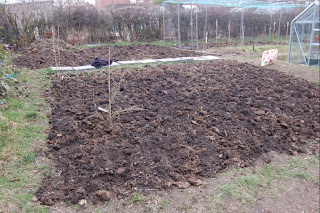When we took on the allotment, we knew we would have a big job to get the soil back into shape. After all, the site hadn't been used for at least a decade. If the soil is no good, we don't get sufficient produce and our dreams of self-sufficiency are gone.
Last year we brought 3 beds into use. They are pictured below (the third bed is top right where the fruitcage is. The first two beds were successful. We manured them well last year and got a good crop of onions, courgettes, beans and peas and especially Swiss chard.
We put potatoes on the third bed but put on hardly any manure. The soil there was damp and contained a great deal of clay. The potatoes were a failure. We have learnt our lesson. Potatoes like lighter, well composted or manured soil. We have used bed 3 for the sight of the fruitcage and it has been well manured. The fruitcage now contains 3 black currants, 3 red currants, 35 raspberries, 2 blueberries and about 60 strawberries.

Beds one and two were manured in January and over the weekend we dug it in. We are rotating the crops obviously so the bed with the courgettes and onions will be swapped with the one that grew chard and beans.
There are beds waiting to be dug. Bed 5 was used last year for strawberries (all now moved to the fruit cage) and this year we will grow the potatoes there, though they will sit next to a nectarine tree and a peach tree, both planted over the weekend, and an apple and a plum tree, both planted last autumn.
Plot 4 was rotovated last year though we didn't use it. As a result, it grew a good crop of grass and the occasional bramble. We spread a thick layer of manure over this bed 2 weeks ago, in the expectation this would smother the grass and help to kill it. When I dug through the manure over the weekend, I found the grass was still green. This experiment may or may not work but we are going to have to do a lot of digging on bed 4.
Anyway, having given all the beds different numbers, it seems to me that I need to draw a plan of the allotment and post it up on this blog. I'll add it to my list of things to do.

In the picture above, I'm on plot two in my mucky jeans and incredibly old and battered gardening trainers. The manure has been dug in so this patch will be ready for planting soon. I spoke to a friend of my today by phone who asked me how my self-sufficiency plans are getting on. He was amused that every time we meet, we are always both in suits and collar and tie. He suggested I needed to be seen more in my wellies, dirty gardening clothes, unshaven and smelling the smell of someone who grows their own food. I don't have my wellies on in the above pic but I certainly had all the other requirements! I since directed Stephen to the photos of me shovelling manure!